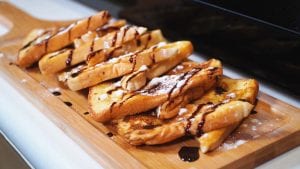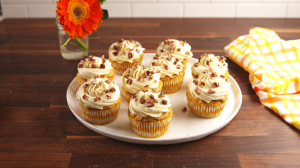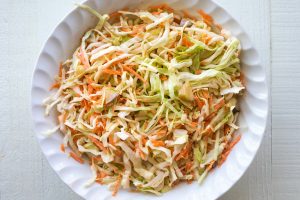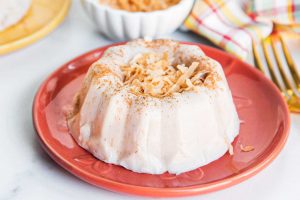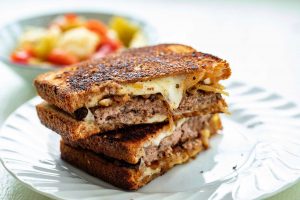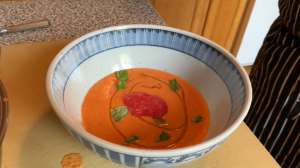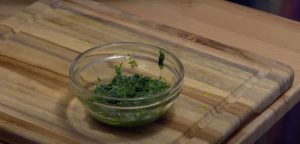This rustic French peasant flatbread is a delightful combination of simplicity and flavor. It brings together basic ingredients to create a delicious, hearty bread that's perfect for any meal. Whether you're serving it as an appetizer, a side dish, or enjoying it on its own, the aromatic herbs and crispy crust make it a crowd-pleaser.
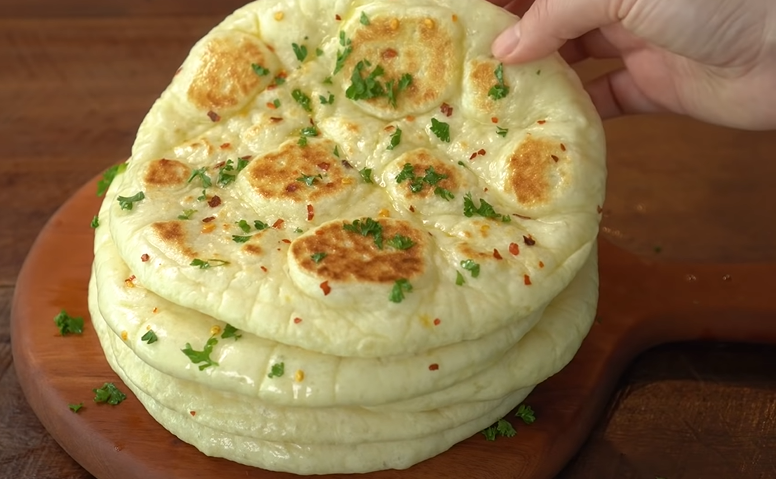
Some of the ingredients in this recipe might not be common in every household. Fresh rosemary and coarse sea salt are essential for the unique flavor and texture of this bread, so make sure to pick them up at the supermarket. Additionally, cornmeal is needed to keep the bread from sticking to the pan and to add a subtle crunch.
Ingredients For French Peasant Flatbread
All purpose flour: This forms the base of the bread, giving it structure and texture.
Warm water: Activates the yeast and helps it rise.
Active dry yeast: Leavens the bread, making it airy and light.
Sugar: Feeds the yeast, helping it to grow and create bubbles in the dough.
Coarse sea salt: Adds flavor and enhances the taste of the bread.
Extra virgin olive oil: Adds richness and moisture to the bread while aiding in the crisping of the crust.
Cornmeal: Prevents the bread from sticking to the pan and adds a slight crunch.
Fresh rosemary: Offers a fragrant and earthy aroma that complements the bread.
Freshly ground black pepper: Adds a bit of spice and depth of flavor.
Water: For misting the dough during baking to create a crispy crust.
One reader, Jammal Todd says:





This French peasant flat bread recipe is fantastic! The crust is perfectly crisp, and the rosemary and black pepper add a delightful flavor. It's easy to make and pairs wonderfully with soups and salads. Highly recommend!
Key Techniques for Making French Peasant Flat Bread
How to dissolve yeast, sugar, and salt: Combine the water, yeast, sugar, and salt in a warm, large mixing bowl and stir with a wooden spoon until they dissolve. How to form a loose dough: Stir in enough flour to create a loose dough and scrape it out onto a prepared plate with a rubber spatula. How to let dough rise: Cover the bowl with plastic wrap and let it rise in a warm place for 45 minutes. How to grease a baking sheet: Grease a rimmed baking sheet with 3 tablespoons of olive oil and sprinkle lightly with cornmeal. How to spread dough in a pan: Spread the dough over the pan, flattening it and pressing it down with the fingertips of both hands to cover the bottom of the pan. How to dimple dough: Work from above so the angle of your fingers hits the dough at 90 degrees to create an evenly dimpled surface. How to brush dough with olive oil: Brush or sprinkle the dough with 3 tablespoons of olive oil. How to preheat the oven: Preheat the oven to 425 degrees F. How to mist with water: Mist the dough lightly with water using a spray bottle. How to reduce oven temperature: Reduce the oven heat to 375 degrees F after the initial baking period. How to cut bread: When the bread is cool enough to handle, slide it onto a cutting board and cut it into pieces with kitchen shears, a chef's knife, or a cleaver.
How To Make French Peasant Flat Bread
French flatbread squares will be great as an appetizer. It’s best if you cut it into pieces while warm and add a little butter or jam upon serving.
Serves:
Ingredients
- 4½cupsall purpose flour,unsifted plus more for the plate
- 2cupswarm water,(110 to 115 degrees F)
- active dry yeast
- 1tbspsugar
- 2tspcoarse sea salt,or kosher salt
- 7tbspextra virgin olive oil
- cornmeal,for dusting the pan
- 2tbspfresh rosemary,or sage leaves, finely chopped
- 1tbspfreshly ground black pepper
- water in a spray bottle,for misting
Instructions
-
Sprinkle a dinner plate with flour.
-
Combine the water, yeast, sugar, and 1 teaspoon salt in a warm, large mixing bowl and stir with a wooden spoon until the yeast, sugar, and salt dissolve.
-
Stir in enough flour to form a loose dough and scrape out onto the prepared plate with a rubber spatula. Immediately slide the dough back into the bowl, flour side down.
-
Cover the bowl with plastic wrap and let rise in a warm place such as on a running clothes dryer or kitchen counter over a running dishwasher for 45 minutes.
-
Grease a rimmed baking sheet with 3 tablespoons olive oil and sprinkle lightly with cornmeal.
-
Spread the dough over the pan, flattening it, and pressing it down with the fingertips of both hands to entirely cover the bottom of the pan.
-
Work from above so the angle of your fingers hits the dough at 90 degrees to create an evenly dimpled surface.
-
Brush or sprinkle the dough with 3 tablespoons olive oil then sprinkle evenly with the rosemary, pepper, and remaining 1 teaspoon of salt.
-
Loosely cover the dough with plastic wrap and let rise for about 45 minutes depending on how thick you want the cooked bread to be.
-
Preheat the oven to 425 degrees F. Bake the dough for 10 minutes, remove from the oven, and drizzle with the remaining 1 tablespoon of oil.
-
Mist lightly with water in a spray bottle and return to the oven.
-
Reduce the heat to 375 degrees F and bake the bread until the crust is crisp and sizzling on the underside for about 15 minutes.
-
When the bread is cool enough to handle, slide it onto a cutting board and cut it into pieces as desired with kitchen shears, a chef’s knife, or a cleaver.
Nutrition
- Calories: 98.43kcal
- Fat: 3.35g
- Saturated Fat: 0.47g
- Monounsaturated Fat: 2.32g
- Polyunsaturated Fat: 0.41g
- Carbohydrates: 14.90g
- Fiber: 0.58g
- Sugar: 0.47g
- Protein: 1.96g
- Sodium: 156.57mg
- Calcium: 27.28mg
- Potassium: 23.94mg
- Iron: 0.92mg
- Vitamin A: 0.23µg
- Vitamin C: 0.02mg
Crucial Technique Tip for French Peasant Flat Bread Recipe
When spreading the dough over the pan, use your fingertips to create an evenly dimpled surface. This technique helps to trap the olive oil and seasonings, ensuring a flavorful and crispy crust.
Time-Saving Tips for French Peasant Flat Bread Recipe
Prepare ingredients in advance: Measure and set out all ingredients before starting. This ensures a smooth workflow and prevents delays.
Use a stand mixer: Instead of mixing by hand, use a stand mixer to combine the dough ingredients quickly and efficiently.
Warm environment: Speed up the dough rising process by placing the bowl in a slightly warmed oven (turned off) or near a warm appliance.
Preheat the oven early: Start preheating your oven while the dough is rising to save time.
Use parchment paper: Line the baking sheet with parchment paper instead of greasing it to save on cleanup time.
Substitute Ingredients For French Peasant Flat Bread Recipe
all purpose flour - Substitute with whole wheat flour: Adds a nuttier flavor and more fiber, though the texture may be denser.
warm water - Substitute with milk: Provides a richer flavor and softer texture to the bread.
active dry yeast - Substitute with instant yeast: Works faster and can be mixed directly with the dry ingredients.
sugar - Substitute with honey: Adds a subtle floral sweetness and helps with browning.
coarse sea salt - Substitute with kosher salt: Has a similar texture and flavor profile, though you may need to adjust the quantity slightly.
extra virgin olive oil - Substitute with grapeseed oil: Has a neutral flavor and high smoke point, making it a good alternative for baking.
cornmeal - Substitute with semolina: Provides a similar texture and helps prevent sticking.
fresh rosemary - Substitute with dried rosemary: Use half the amount as dried herbs are more concentrated in flavor.
freshly ground black pepper - Substitute with white pepper: Offers a milder flavor and a slightly different aroma.
water in a spray bottle - Substitute with milk in a spray bottle: Helps achieve a golden crust and adds a slight richness.
Presentation Ideas for French Peasant Flat Bread
Serve smaller portion sizes: Cut the flatbread into elegant, bite-sized pieces to create a refined presentation. This allows for a more sophisticated tasting experience.
Use decoration: Garnish the flatbread with a sprig of fresh rosemary and a light drizzle of extra virgin olive oil to enhance the visual appeal and aroma.
Plate on a wooden board: Present the flatbread on a rustic wooden board to evoke the essence of French peasant cuisine while maintaining a high-end aesthetic.
Add a dipping sauce: Accompany the flatbread with a small bowl of extra virgin olive oil infused with fresh rosemary and black pepper for an added layer of flavor and sophistication.
Highlight texture: Ensure the flatbread is visibly dimpled and golden-brown, showcasing its crisp crust and airy interior. This visual cue will entice diners and emphasize the bread's artisanal quality.
Use a clean, white plate: For individual servings, place the flatbread pieces on a clean, white plate to create a stark contrast that highlights the bread's rustic charm and the vibrant colors of the rosemary and olive oil.
Incorporate seasonal ingredients: Add a few thin slices of heirloom tomatoes or a sprinkle of sea salt flakes to the flatbread to introduce seasonal flavors and elevate the dish's complexity.
Create height: Stack a few pieces of flatbread slightly askew to add height and dimension to the presentation, making the dish visually dynamic and appealing.
Use a drizzle bottle: For precision, use a drizzle bottle to apply the olive oil and any additional garnishes, ensuring an even and aesthetically pleasing distribution.
Finish with a touch of sea salt: Just before serving, sprinkle a pinch of coarse sea salt over the flatbread to enhance the flavor and add a touch of elegance.
Essential Tools for Making French Peasant Flat Bread
Dinner plate: Used to sprinkle with flour and temporarily hold the dough.
Wooden spoon: Utilized for stirring the water, yeast, sugar, and salt mixture.
Large mixing bowl: A warm bowl to combine the ingredients and allow the dough to rise.
Rubber spatula: Helps in scraping the dough out of the bowl and onto the plate.
Plastic wrap: Used to cover the bowl and dough during the rising process.
Rimmed baking sheet: Greased with olive oil and sprinkled with cornmeal to bake the dough.
Spray bottle: Filled with water to mist the dough before the final baking.
Oven: Preheated to 425 degrees F and later reduced to 375 degrees F for baking the bread.
Cutting board: Used to place the baked bread for cutting.
Kitchen shears, Chef's knife, or Cleaver: Tools for cutting the baked bread into pieces.
Storing and Freezing French Peasant Flat Bread
- Allow the French peasant flat bread to cool completely before storing or freezing.
- To store at room temperature, wrap the bread tightly in plastic wrap or aluminum foil and place it in a sealed container or plastic bag. It will keep for up to 3 days.
- For longer storage, freeze the bread by wrapping it tightly in plastic wrap, followed by a layer of aluminum foil. Place the wrapped bread in a freezer-safe container or plastic bag, removing as much air as possible before sealing. Label the container with the date and freeze for up to 3 months.
- To thaw frozen bread, remove it from the freezer and let it thaw at room temperature, still wrapped, for about 2 hours or until it reaches room temperature.
- To reheat the bread, preheat the oven to 350°F (175°C). Unwrap the bread and place it on a baking sheet. Bake for 5-10 minutes, or until heated through and the crust is crispy again. You can also mist the bread lightly with water before reheating to help restore its texture.
- If you prefer a softer crust after reheating, wrap the bread in aluminum foil before placing it in the oven. This will help prevent the crust from becoming too crispy.
- Leftover French peasant flat bread can be used in various ways, such as making croutons, breadcrumbs, or as a base for open-faced sandwiches or crostini.
How To Reheat Leftover French Peasant Flat Bread
To reheat leftover french peasant flat bread, preheat your oven to 350°F (175°C). Wrap the bread loosely in aluminum foil and place it on a baking sheet. Bake for 10-15 minutes, or until the bread is heated through and the crust is crispy once again. This method helps to restore the bread's texture and flavor without drying it out.
Another option is to use a toaster oven. Place the bread directly on the toaster oven rack and heat for 5-7 minutes at 350°F (175°C). Keep an eye on the bread to ensure it doesn't burn. This method is quick and convenient, especially if you're only reheating a small portion.
For a softer crust, wrap the bread in a slightly damp paper towel and microwave it on high for 15-20 seconds. This method is best for small pieces of bread and when you're in a hurry. However, be careful not to overheat the bread, as it can become soggy.
If you have a panini press or a grill pan, you can reheat the bread while adding a delightful crunch. Preheat the press or pan to medium heat, then place the bread inside and close the lid (or press down gently with a spatula if using a grill pan). Heat for 2-3 minutes on each side, or until the bread is warmed through and has a crispy exterior.
For a flavorful twist, brush the bread with a little olive oil or garlic butter before reheating. This will add a delicious aroma and taste to your leftover bread, making it feel like a fresh, gourmet experience.
Is Making French Peasant Flat Bread at Home Cost-Effective?
The French peasant flatbread recipe is quite cost-effective for a household. The primary ingredients like flour, yeast, and olive oil are inexpensive and commonly found in most kitchens. Fresh rosemary and black pepper add a gourmet touch without breaking the bank. Overall, this recipe scores an 8 out of 10 for cost-effectiveness. The approximate cost for a household of 4 people is around $5-$7 USD, making it an affordable yet delicious option.
Is French Peasant Flat Bread Healthy or Unhealthy?
The French peasant flat bread recipe, while delicious, may not be the healthiest choice due to its high carbohydrate content from the all-purpose flour. The recipe also includes a significant amount of olive oil, which, although a healthier fat option, can still contribute to a higher calorie count. However, the inclusion of fresh rosemary does provide some beneficial antioxidants and flavor without adding extra calories.
To make this recipe healthier, consider the following suggestions:
- Substitute a portion of the all-purpose flour with whole wheat flour or other nutrient-dense alternatives like almond flour or chickpea flour to increase fiber and protein content
- Reduce the amount of olive oil used in the recipe to lower the overall calorie count
- Experiment with adding other herbs and spices, such as garlic, thyme, or oregano, to enhance flavor without increasing calorie content
- Serve the flat bread with nutrient-rich toppings like fresh vegetables, hummus, or low-fat cheese to create a more balanced meal
Editor's Opinion on French Peasant Flat Bread Recipe
This French peasant flatbread recipe is a delightful blend of rustic simplicity and rich flavors. The use of rosemary and freshly ground black pepper adds a fragrant, earthy aroma that complements the crisp, golden crust. The technique of dimpling the dough ensures an even texture, while the olive oil and sea salt enhance the bread's savory profile. The step of misting with water creates a perfect crust, making it both crispy and chewy. Overall, this recipe is a wonderful homage to traditional French baking, offering a satisfying and flavorful bread that's perfect for any meal.
Enhance Your French Peasant Flat Bread Recipe with These Unique Side Dishes:
Similar Recipes to French Peasant Flat Bread
Why trust this French Peasant Flat Bread Recipe:
This French peasant flatbread recipe combines simple, wholesome ingredients like all-purpose flour, extra virgin olive oil, and fresh rosemary to create a delicious, rustic bread. The step-by-step instructions ensure a foolproof process, while the use of coarse sea salt and freshly ground black pepper adds a burst of flavor. Perfect for both novice and experienced bakers, this recipe promises a satisfying homemade bread experience.
Was this page helpful?
Have your own special recipe to share? Submit Your Recipe Today!

